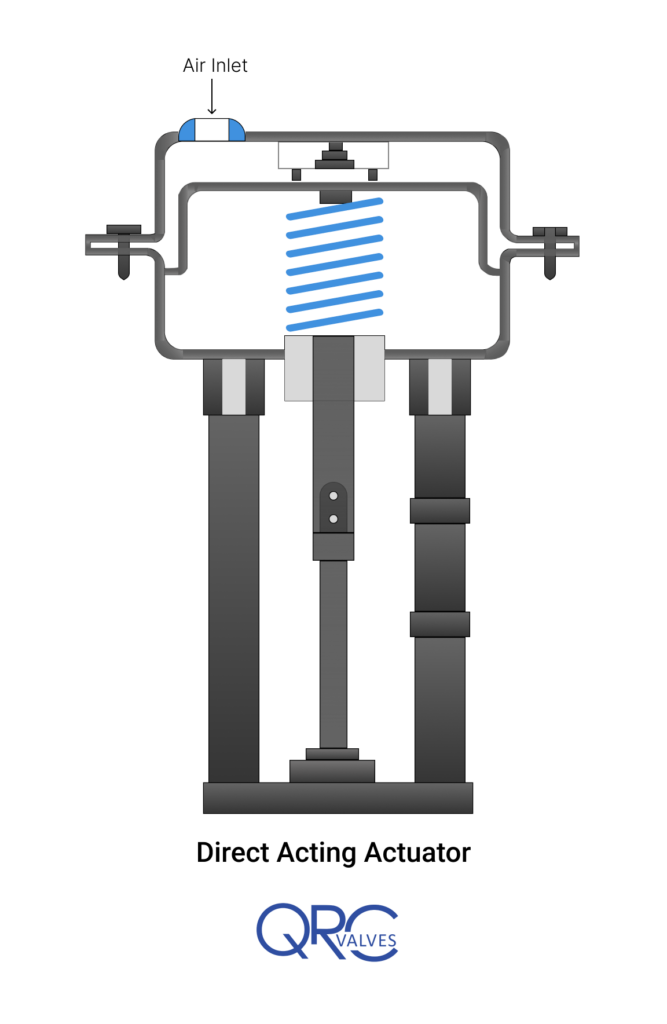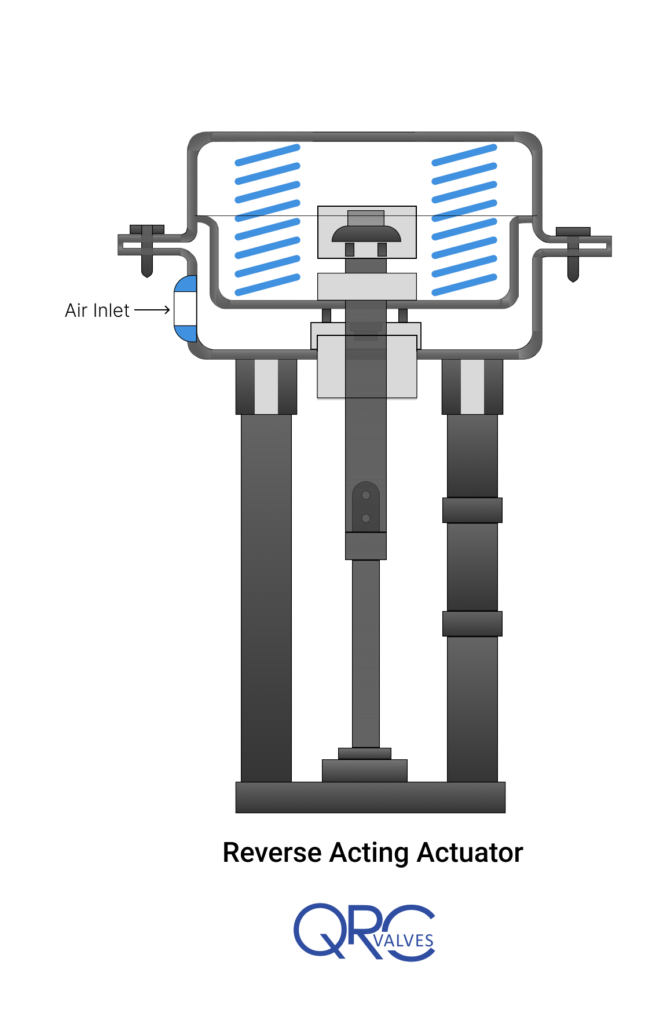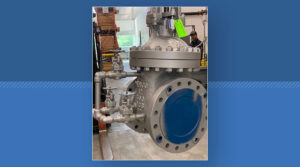
Direct Acting vs Reverse Acting Actuator
Actuators perform important functions in valves, especially control valves. Common operations performed include fully opening, fully closing, and providing precise control for flow regulation. Direct acting and reverse acting provide two methods by which actuators control a valve. In this article, we review the operations of a direct acting and a reverse acting actuator and compare the two.
How a Direct Acting Actuator Operates
Both direct-acting vs reverse-acting methods involve the use of an actuator that opens or closes a valve in response to a process variable (PV). This variable could be flow, pressure, temperature, electrical signal, or another system input.
For a direct-acting actuator, an increase in the controller output coincides with more output from the valve. For example, in a pneumatic/spring sliding stem valve with the air port above the diaphragm, an increase in air pressure causes the diaphragm to push down the stem. In a “push-down-to-close” (PDTC) valve, this action results in the closing of the valve. Whereas in a “push-down-to-open” (PDTO) valve, this actuator action opens the valve. So, this configuration with a PDTO valve means the actuator is direct acting, because an increase in the air pressure also increases valve output.
Another key feature to consider when using a direct-acting actuator is whether it should be fail-open or fail-close. The appropriate option is determined by the safety requirements of the system. If a direct acting actuator on a PDTO valve is fail-open, then the return spring will be above the diaphragm, while the air inlet port should be below the diaphragm. As a result, the spring pushes the stem down to open the valve on loss of air pressure. On the other hand, if it is to be fail-close, the inlet port will be above the diaphragm with the spring below to push the stem up when there is no air pressure.
How Reverse Acting Actuator Operates

A reverse acting actuator works in the opposite way to the direct acting actuator. For a reverse acting actuator, an increase in the process variable signifies a reduction in controller output. An increase in the controller output coincides with a reduction in the process variable.
Using the same pneumatic/spring sliding stem valve example means an increase in pressure lifts the diaphragm and the stem. The actuator in this setup is reverse acting only if it is a PDTO valve so an increase in controller output minimizes the valve output. If it is a PDTC valve, then the port should be above the diaphragm.
Similarly, the configuration of the spring and diaphragm in this type of valve determines if it will fail-open or fail-close. If the air entry into the pneumatic valve is below the diaphragm, the compression spring should be below it to pull it down on the loss of air pressure.
In a PDTC valve, this setup makes it fail-close, whereas, in a PDTO valve, it fails-open. If the configuration is reversed with the inlet above the diaphragm, then the spring also pushes the stem upon loss of pressure. For a PDTC valve, this design delivers a fail-open valve but will be fail-close in a PDTO valve.
Comparing Methods of Operation
The differences between direct acting vs reverse acting actuator centers around the basic elements of a control loop.
- Control Signal: The control signal could be the process under control or could be an alternative variable that governs the valve control. In a pneumatic valve, this is the air pressure, while in a control valve for air heating, it is the air temperature.
- Process Controller: This element receives the control signal and initiates a control action via the valve positioner.
- Valve Positioner: The valve positioner, when in use, has its action determined by the output of the controller.
- Control Valve Action: A combination of the control signal, controller, and positioner determines if the final valve action is to increase or reduce flow.
| Control Loop Element | Direct Acting Actuator | Reverse Acting Actuator |
| Controller | Controller output increases as the process variable increases. | Controller output decreases as the process variable increases. |
| Positioner | As the input signal to the valve positioner from the controller increases, the output from the valve increases. | Increase in the input signal to the valve positioner from the controller results in a reduction in valve output. |
| Control Valve Action | Increasing signal from the positioner results in control valve action towards the open position. | Increasing signal from the positioner leads to control valve action towards the close position. |
Another example that distinguishes direct vs reverse acting actuator systems is an air heater that regulates hot water flow in a heat exchanger using a control valve. If the system is fail-open, then the actuator needs to be direct acting. Why? So an increase in the temperature (control signal) results in an increase in the controller action to close the valve. But if it is an air cooling system that is also fail-open, the actuator should be reverse acting. Because as the temperature rises, there should be less controller action, and the valve can open to allow more chilled water to cool the space.


